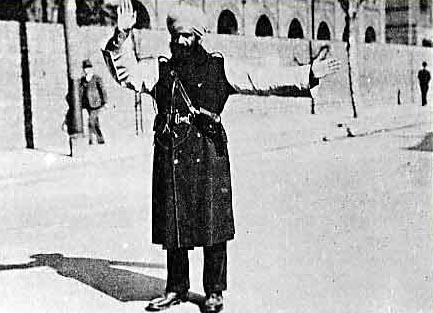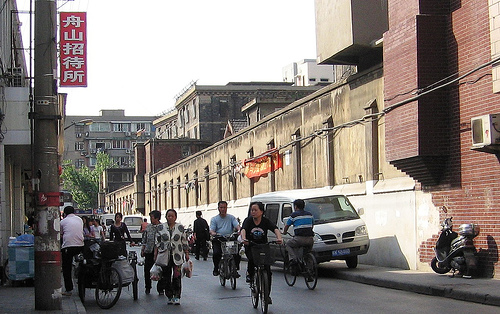Ward Road Jail
in Shanghai
Apparently only the following North China Marines were held here:Connie Battles, Charles Brimmer, Charles Stewart, Jerold Story, and Douglas Bunn. The first four escaped Woosung and were sent to Ward Road Jail after their recapture. Story then escaped from Ward Road. See Escapes and Deaths.
Bunn's story is related below. Douglas A. Bunn related this story to me in a phone conversation on 3 Feb 2003. When Kiangwan was closed down in May 1945 and the entire camp sent to Fengtai and then Japan, Bunn was kept behind (as were about 25 others for because of health/medical problems) due to a broken leg. He was then sent to Ward Road Jail. A few weeks later (unsure of time) he escaped from Ward Road Jail when a bombing raid hit the building. He fastened a cast of wood and made it to the outskirts of Shanghai before he was recaptured. He was forced to cross a river on a bridge and was spotted doing so. (This information on escape and capture does not appear in an oral debrief done with the USMC Historical Division.) After recapture he was taken to Nanking. He thinks he was there a few weeks but is again unsure because the Japanese "beat the piss out of me". From Nanking he was taken to Fengtai. There he was the only American with a couple of British POWs. US forces parachuted in. He was flown out of Fengtai in the bomb bay of a B-25. They flew to Chunking. He spent a couple of weeks in a hospital there or near there. He had a bad case of malaria. From the hospital he flew to Calcutta, Karachi, Cairo, the Azores, and then the states. These are the stops he remembers. His version of being flown out of Fengtai and the stops on the way back to the states follows the version given in the Commander Cunningham information, so Bunn probably left Fengtai in late August with the other American POWs. Doug Bunn was shot while on guard duty in Peking in October of 1941. See Chittenden book page 105. At the time of this conversation Doug Bunn was the head of the AX-POW chapter in his area of Ohio.
PRISONER OF MAR CAMPS IN AREAS OTHER THAN THE FOUR PRINCIPAL ISLANDS OF JAPAN
LIAISON & RESEARCH BRANCH AMERICAN PRISONER OF WAR INFORMATION BUREAU
by CAPT. JAMES I. NORWOOD & CAPT. L. SHECK 31 July 1946
WARD ROAD JAIL, CHINA
1. LOCATION:
Ward Road Gaol or more commonly known as Ward Road Jail was formerly the Shanghai Municipal Council Jail. It was built in 1934, a modern 5 story concrete building and was situated on Ward Road. It was bounded on one side by Kwen Ming Road and the other side by Pao Ting Road and just about a quarter of a mile north of the Whangpoo River in the Hongew district. It was maintained by the Japanese as a place for political prisoners
and criminals.
2. PRISONER PERSONNEL:
In June 1942 there were about 8000 prisoners in this institution. Out of this number there were approximately 100 foreigners. At no time were there more than 12 Americans.
These Americans were the civilians, Navy, & Marine personnel sentenced by the Japanese courts to penitentiary punishment.[Marines Battles, Brimmer, Stewart, Story, Bunn, Coleson, Herndon, Pharmacist Mate Brewer, Commanders Smith and Cunningham, civilian Teters] Teters was given a two year sentence to Ward Road Jail for his involvement in the escape and was returned to the military POW camp in 1944.Bunn ended up here after the Kiangwan camp was closed down in May 1945. Some or all of the approx 25 POWs not transferred to Japan at this time may also have been sent to Ward Road.
3. GUARD PERSONNEL:
When the Japanese first took over Shanghai a Japanese official was made governor of the jail but the British and Russian officials and warders who were in charge of the jail continued on in their various capacities. They had protested and asked to be relieved but it was a year before their request was granted. They then were put into concentration
camps. A Japanese civilian, Mr. Mori, then became the head jailor and the Chinese and Sikhs continued to remain as guards.
4. GENERAL CONDITIONS: Due to the fact that it was a very modern type of Jail, conditions were good, except in the winter. There was no heat and the prisoners would remain in bed to keep warm.
(a) HOUSING FACILITIES: The jail was a 5 story concrete building, separated into individual cells, each cell had an overhead electric light, a small table, a stove and wooden bed. Due to the lack of fuel in the Shanghai area the entire building was never heated.
(b) LATRINES: Each cell contained a flush toilet and It was up to the occupant to keep his cell clean.
(c) BATHING; On every floor there were wash rooms and at certain times of the day the prisoners were allowed to wash. A hot bath was available once a week.
(d) MESS HALL: The kitchen was on the 1st floor of the jail and the food was prepared by criminal prisoners. Other prisoners were never allowed in the kitchen. The guards served the food to the prisoners of war.
(e) FOOD: Only 2 meals a day were served here, namely, at 8 in the morning and at 4 in the afternoon. Breakfast consisted of a cup of boiled barley, dinner was a watery soup, about 16 ounces of bread per day was given to the prisoners. The food was never good or adequate but it gradually deteriorated both in quality and quantity. There was ample drinking water and tea was available twice a day.
(f) MEDICAL FACILITIES: Prisoners that required medical care were attended by Chinese doctors from the Shanghai Municipal Health Department. These doctors treated the Americans very well when no Japanese officials were around.
(g) SUPPLIES: In the summer the prisoners were issued a jail uniform of white cotton. In the winter they were issued an old wool unifonn. These uniforms had to be worn during their imprisonment. They also were issued blankets but during the winter months these blankets were not adequate. In 1943 the International Red Cross was able to supply the Americans with blankets and mattresses and through bribing the jailors, they were
allowed to send in some canned food every month. Special books requested by prisoners also were sent in by the YMCA.
(h) MAIL: Mail was received 3 or 4 times. Prisoners were allowed to write a letter each 3 months and a postcard each month.
Work: The American prisoners were not forced to work but they volunteered for outside work. Outside work consisted of tending the vegetable and flower gardens.
Treatment: The Americans were never treated inhumanely. They managed to be on fairly good terms with the jailors and the officials, chiefly through the efforts of Mr. Mori, whose mother was an American.
Pay: Through the Swiss Consulate $700 CRB (Chinese) was deposited each month in the jail to the credit of each American prisoner. As the exchange grew higher the sum varied so that towards the end prisoners received $2400 CRB. The Japanese officials always took a cut of 30 to 40 percent, and the prisoners had to sign a statement with a fixed exchange. The prisoners never saw the money but they would make a list of things they wanted from the outside, and the Chinese guards would draw the money from Mr. Mori and do their shopping.
Recreation: No games of any kind but they were allowed one hour of exercise each morning and afternoon. There was a fairly decent library and the prisoners had access to the books, which had been furnished by the YMCA.
Religious activities: A civilian Catholic priest was confined here and was allowed to hold services every Sunday.
Morale: good
Movements: In October 1944 eight Marines and Navy personnel and civilians escaped from this jail. Three made their way to free China and the other five were recaptured almost immediately.
(Most, if not all, American military POWs held here were apparently transferred to Nanking and then Peking in the last months of the war.)
End Report
Navy Commander C.D. Smith was one of the Americans held here. He was involved in the first escape from Woosung, along with British Commander Wooley, American Navy Commander Cunningham, civilian (from Wake Island) Dan Teters, and Smith's Chinese "boy" Liu. Smith describes Ward Road in the book Officially Dead.
It was surrounded by a twenty-five foot high wall. Inside was a huge rotunda. On it were attached seven storied blocks of cells like spokes on a wheel. Each of the Allied prisoners were kept in separate cells, fairly large, with a flush toilet and running water. The windows were barred, the door was steel with a barred window. They were given a cup of boiled barley each morning and a thin watery soup at night, along with sixteen ounces of bread-even though it was 30% ground wood fiber. There was plenty of drinking water and hot tea twice a day. The were given about an hour outside their cells each day. They had books available from the prison library and easy contact with friends in the Shanghai area. Items were smuggled into the prison, often with the help Japanese staff.
Eventually the non Japanese guards were replaced with Japanese troops but there were still Chinese and other workers inside the prison. Food quantity was gradually dropped to about half of what they were given when first sent to Ward Road. - Street view of Ward Road Jail below.


This is the wall of Ward Road Jail the escapees in October 1944 had to scale and drop into the street. Photo courtesy of John Meckley.
A modern day description of the interior mentions an open area where green plants were grown. Jerold Story talks about hiding material for the escape in a garden he was allowed to work in. Others say this garden never existed. Unless this area was added later it may well be the area mentioned in the description from about the year 2000.
click here to Return to POW Camps
click here to Return to Main Page